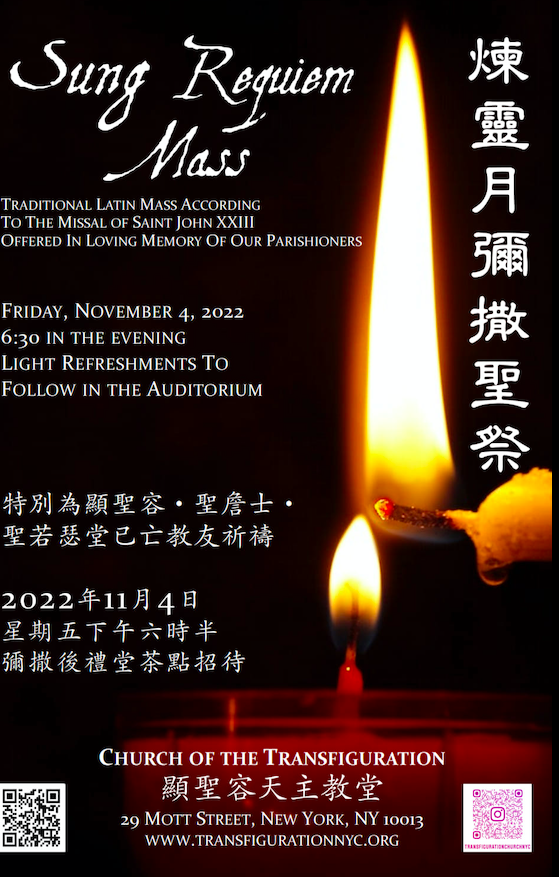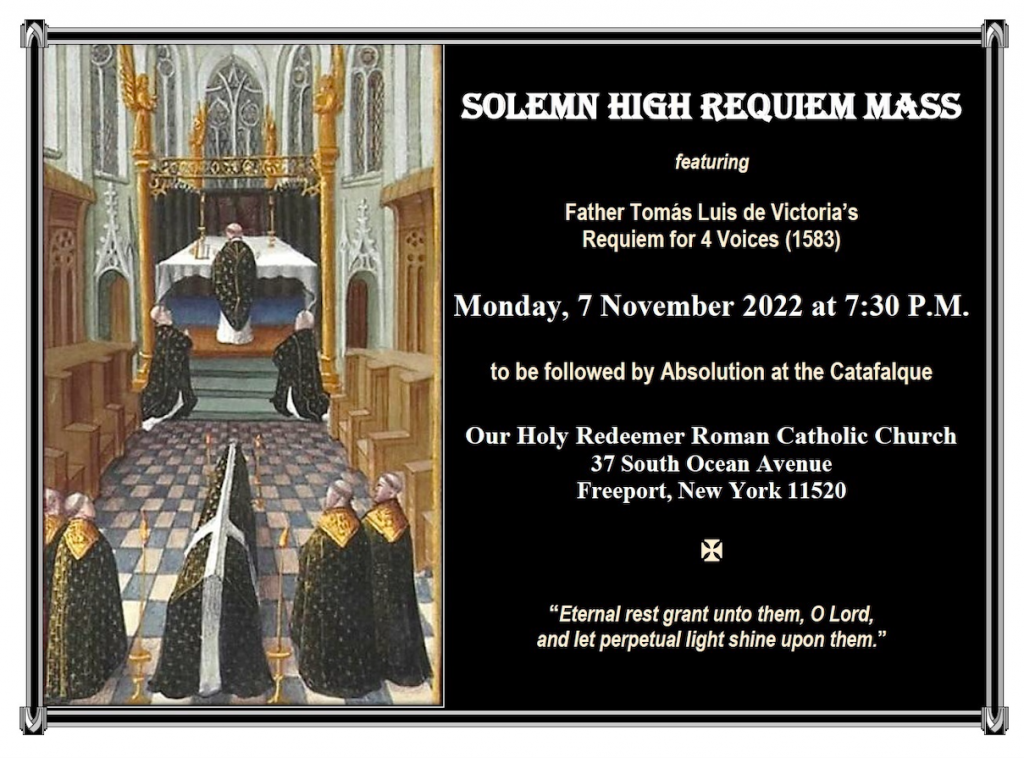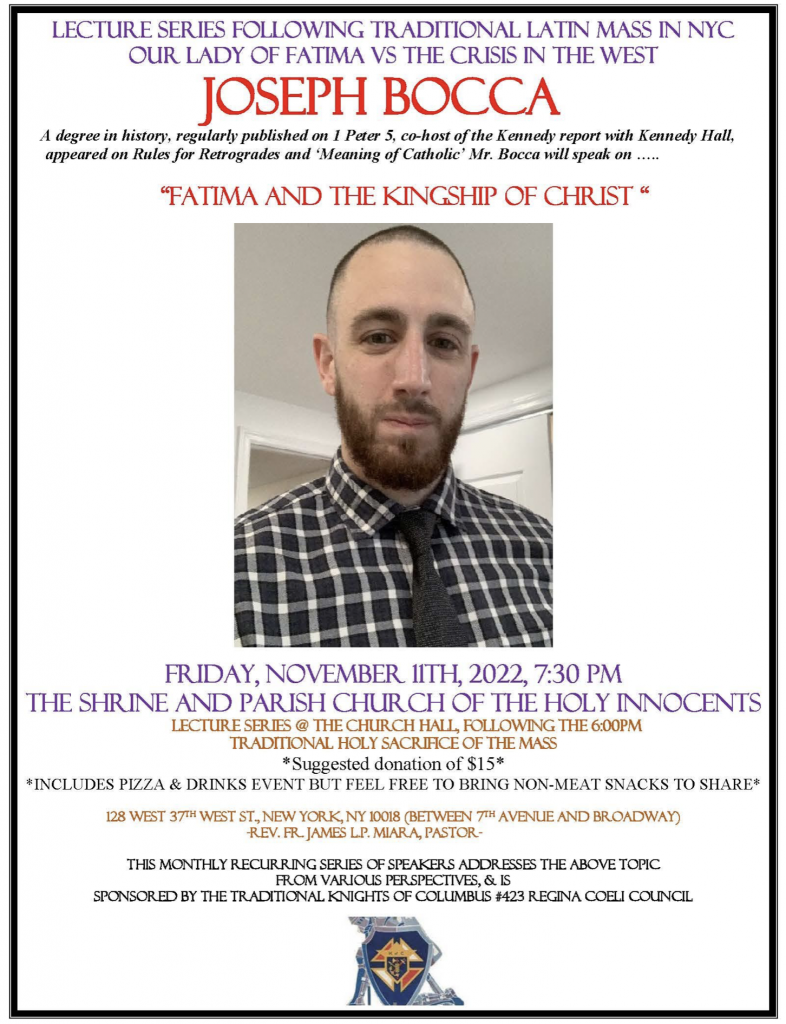
3
Nov
3
Nov
29
Oct
November 1, All Saints Day
Connecticut
St. Mary Church, Norwalk, CT, Solemn Mass, 7 pm
Sts. Cyril and Methodius, Bridgeport, Low Mass 7:45 am; Missa Cantata 6 pm
St. Pius X Church, Fairfield, Missa Cantata, 7 pm
St. Margaret Bourgeoys, Brookfield, CT, Solemn Mass, 6 pm followed by a convivium.
Sacred Heart Oratory, Georgetown, CT, Missa Cantata, 6 pm
St. Patrick Oratory, Waterbury, Low Mass 8 am, High Mass 6 pm
St. Augustine Church, North Branford, CT, 6PM Sung Mass
St. Martha Church, Enfield, CT, 7 pm
New York
Our Lady of Mount Carmel, NY, Low Mass 7 am and 7:45 am; Solemn Mass 7 pm
Church of the Holy Innocents, New York, 8 am, 6 pm.
St. Paul the Apostle, Yonkers, 12 noon.
Annunciation Church, Crestwood, NY, 7 pm (lower church)
Immaculate Conception Church, Sleepy Hollow, NY, Low Mass, 7 pm
St. Josaphat, Bayside (Queens), 7 pm
St. Matthew, Dix Hills, NY (Long Island), High Mass 10:30 am
St. Rocco, Glen Cove (Long Island), Missa Cantata, 7 pm
St. Mchael the Archangel, Farmingville (Long Island), 8 am and 7 pm
New Jersey
Our Lady of Sorrows, Jersey City, 5 pm
Our Lady of Victory, Harrington Park, NJ, Low Mass, 5:30 pm
St. Antony of Padua, West Orange, 9 am, 7 pm
Our Lady of Fatima, Pequannock, 7 am, 9 am, 12, 7 pm sung Mass
Corpus Christi Church, South River, NJ, Missa Cantata, 7 pm
Shrine Church of the Blessed Sacrament, Raritan, NJ, 7 pm
November 2, All Souls Day
Connecticut
St. Mary Church, Norwalk, CT, Solemn Mass, 7 pm
Sts. Cyril and Methodius, Bridgeport, 7:45 am, 8:20 am; Solemn Mass and Absolution at 6 pm.
St. Pius X Church, Fairfield, CT, Missa Canata, 6 pm
St. Margaret Bourgeoys, Brookfield, CT, 6:10 am Low Mass (no sermon), 6:30 Low Mass (English Sermon), 7:00 Low Mass (Spanish Sermon)
Sacred Heart Oratory, Georgetown, CT, Missa Cantata, 6 pm, followed by a Bede Roll for those remembered with Soul Lights immediately after. Soul Cakes will be distributed after prayers offered.
St. Patrick Oratory, Waterbury, Low Mass 8 am, 8:30; High Mass and Absolution 6 pm (note: Communion given only at 8 am and 6 pm Masses)
St. Martha Church, Enfield, CT, 7 pm
New York
Most Holy Redeemer, New York, Solemn Mass, 7 pm. Music: Messe de Requiem, Gabriel Faure.
Our Lady of Mount Carmel, New York, Low Mass 7 am and 7:45 am; Solemn Mass 7 pm.
Church of the Holy Innocents, New York, low Mass 8 am; high Mass 6 pm
St. Paul the Apostle, Yonkers, 12 noon.
Annunciation Church, Crestwood, NY, 7 pm (lower church)
Immaculate Conception, Sleepy Hollow, NY, High Mass, 7 pm
St. Josaphat, Bayside (Queens) 7 pm
St. Matthew, Dix Hills, NY, Sung Requiem, 10:30 am
St. Rocco, Glen Cove, NY, Missa Cantata, 7 pm
St. Michael the Archangel, Farmingville, NY, three Massesa in succession, starting at 8 am.
New Jersey
Our Lady of Sorrows, Jersey City, 7 pm
Our Lady of Victory, Harrington Park, NJ, Low Mass, 5:30 pm
St. Antony of Padua, West Orange, 9 am, 7 pm
Our Lady of Fatima, Pequannock, 7 am, 7:30, 8, 9, 9:30, 10, 12, 12:30, 7 pm high Mass.
Corpus Christi Church, South River, NJ, Sung Mass, 6:15 pm
Shrine Church of the Blessed Sacrament, Raritan, NJ, 7 pm


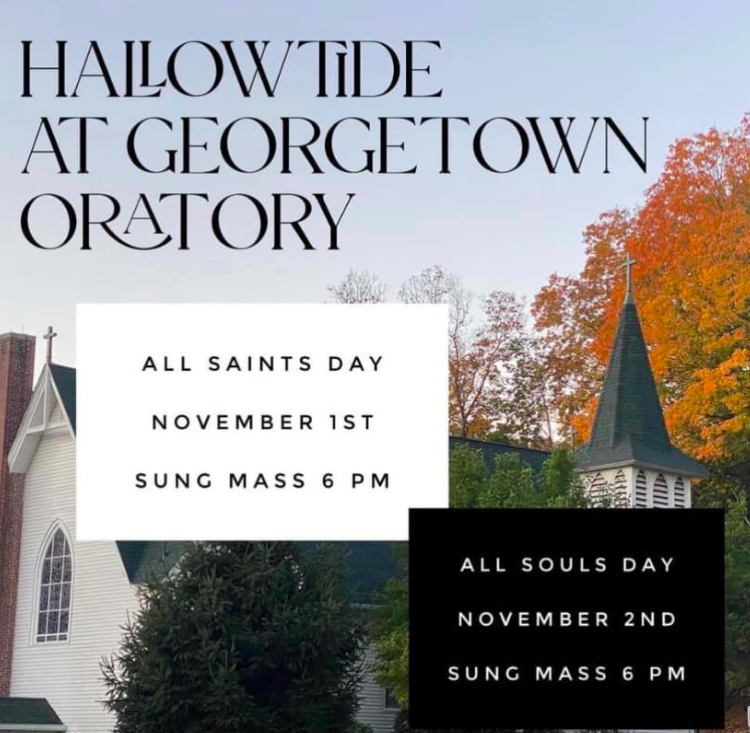


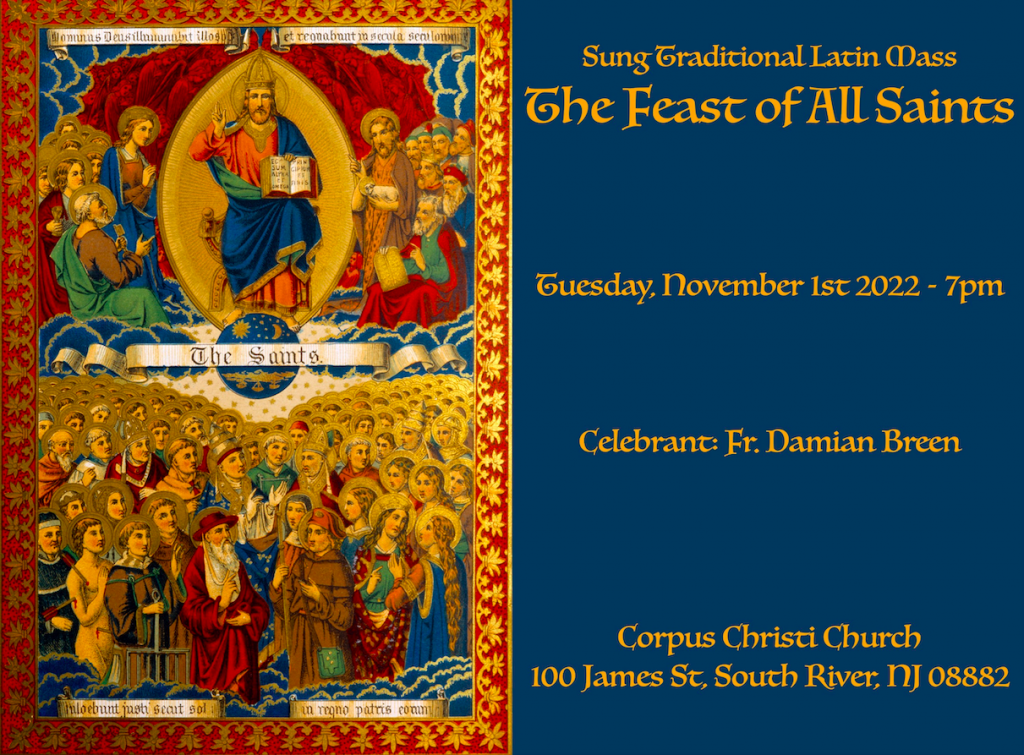
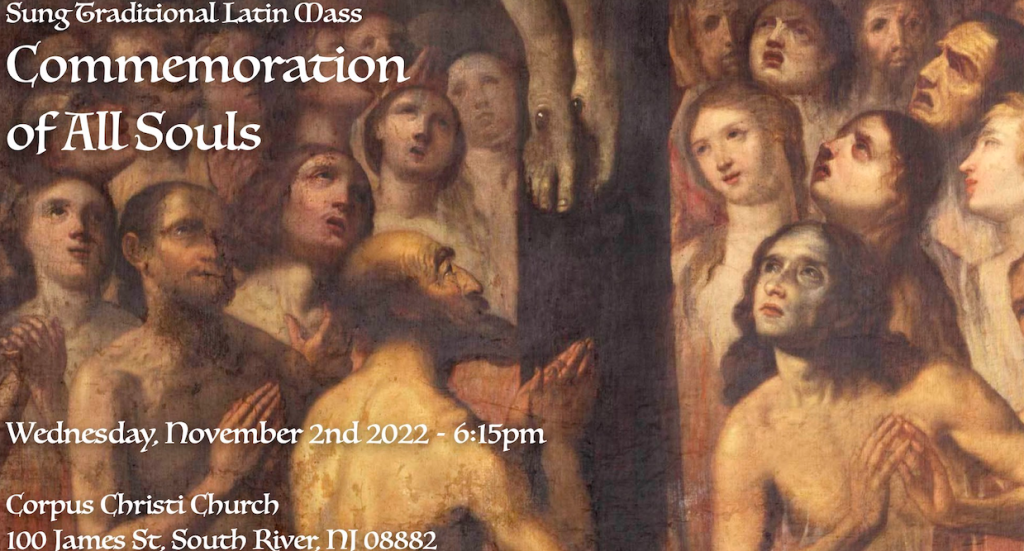
29
Oct
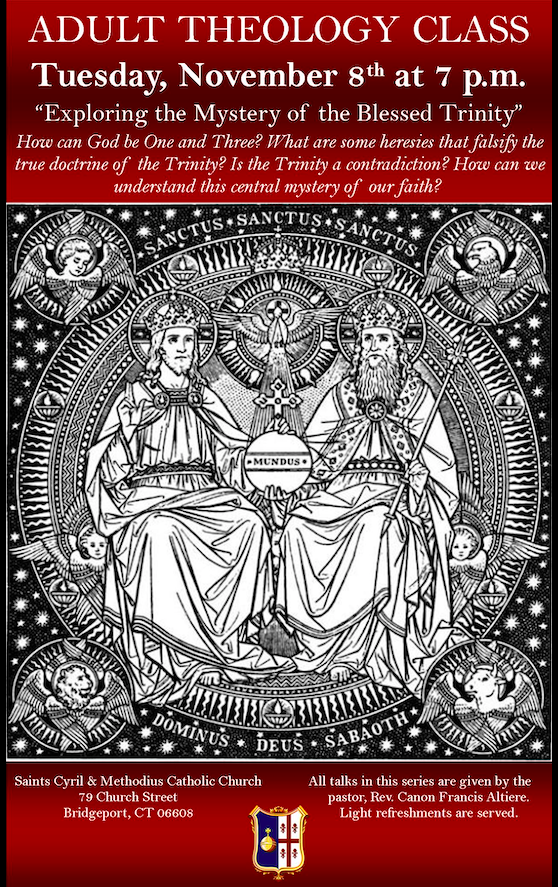
At the Oratory of Sts. Cyril and Methodius in Brideport, Canon Altiere has been offering a series of adult theology classestypically on a Tuesday evening at 7 pm. The next talk is on Tuesday November 8th on the Blessed Trinity.
Exploring the Creed
Talk 1 : Faith and Reason (September 20 th )
Talk 2: Sacred Scripture (October 4 th )
Talk 3 : God – His Existence and Perfections (October 18 th )
Talk 4: The Blessed Trinity (November 8 th )
Talk 5: Creation and the Angels
Talk 6 : Man and the Fall
Talk 7 : Jesus Christ, True God and True man
Talk 8 : The Redemption
Talk 9 : The Blessed Virgin Mary
Talk 10: Christ’s Church
Talk 11: The Church – People and Hierarchy
Talk 12: The Last Things
21
Oct
Tomorrow (Saturday, October 22nd) at 9:30am, St. Vincent Ferrer’s Church in New York, will have it’s first regular traditional low Mass on Saturdays.

21
Oct
As the nature of the policies of Pope Francis became clear, American conservative Catholicism quickly found itself in a grave dilemma. No other tendency within the Church had placed so much weight on loyalty to the papacy as the ultimate criterion of Catholicity. Yet the new pope, while insisting on absolute loyalty to his person, systematically rejected or reduced to a nebulous ideal everything for which the conservatives had fought: ”life issues” (especially opposition to abortion), alliances with evangelical Christianity, their opposition to socialism, liturgical abuses, “LGBT” and the entire progressive Catholic agenda. The pope regularly coarsely denounces revered conservative champions. (EWTN, for example, is claimed to be “doing the work of the devil”). And in the greatest humiliation of all for the conservatives, a hail of disparaging remarks and insinuations continued to shower down from Francis’s entourage on the Catholic Church in America and on the United States in general. All this commenced, of course, years before Francis launched his war on traditionalist Catholics. But even amid this campaign, in word and deed, Francis and his sycophants continue to make clear that all adversaries of the Left are also their targets.
The conservative movement has been searching for a response. To their credit, few were able to follow the example of clerical institutions like Opus Dei and celebrate the steps the pope is taking against them. Instead, some conservatives simply withdrew into silence. Others surreptitiously shifted into a quiet alignment with the positions of the traditionalists, their erstwhile adversaries. Still others denounced the ever-increasing number of outrages in the Church while avoiding mentioning the Pope’s role in them. I myself considered that, in view of this, conservative Catholicism had reached the end of the road, that from now on the landscape of the Catholic right would be dominated by traditionalism.
Indeed, the drift to traditionalism – or at least the openness to traditionalist thought – among conservatives has continued to progress. But I was a bit hasty in my expectations regarding the demise of the entire movement. After more than nine years of the reign of Francis, conservative advocates have returned to the secular media – as conservatives, but without the pope. They champion conservative Catholic issues – sometimes now even including the right to attend the Traditional Mass. But they are forced to argue without the benefit of reliance on authority. Let us look at some of their recent products.
Michael Warren Davis speaks of “us trads.” 1) He writes of the beauty of the Latin Mass. But what is exactly his position? Although Davis claims to be a “trad,” his positions resemble much more closely those of a Catholic conservative. According to Davis:
As many of you know, there is a powerful clique of Catholic bishops who oppose the Traditional Latin Mass. ….Last year, Pope Francis published his apostolic letter Traditionis Custodes. It gave those anti-TLM bishops the excuse they needed to beginshutting down their Latin Mass parishes in their dioceses.
That is the last reference to Pope Francis in Davis’s article. I don’t think many people would characterize the relationship between Traditionis Custodes and the subsequent actions of the bishops in this manner. The bishops’ enforcement actions are clearly the intended result of Traditionis Custodes and indeed reflect some coordination with the Vatican. Of course, Davis earlier had propagated the utterly erroneous notion that Pope Francis had once been indifferent or even favorable to the Traditional Mass.
Naturally, Davis thinks whatever is happening now is largely the fault of the traditionalists themselves:
No doubt they (the anti-Traditional Mass bishops – SC) would cite the army of bloggers, vloggers, and Twitter trolls who devote themselves to castigating the hierarchy. And it’s true: some of these traditionalists say things about the pope that would make Martin Luther blush. So, if your only exposure to traditionalist Catholics came via the internet, you might agree that TLM is a bad influence.
Look: I’m the first to admit that there are problems in the Latin Mass community… I’ve bent over backwards to give our bishops the benefit of the doubt.
I even have a soft spot for Cardinal Gregory…I have to believe that he truly loves Jesus Christ and His holy Church.
Why does Davis “have to” believe that? Is he Gregory’s confessor? As he has done in the past, Davis is denouncing those he is claiming to defend – and whose rights have been violated – while “bending over backwards” to excuse the establishment.
So why does Archbishop Gregory do what he does?
There’s only one answer that makes any sense. Cardinal Gregory doesn’t understand the desire for beauty in worship.
So, you see, Gregory is just aesthetically challenged. Davis has a profound misunderstanding of Catholicism if he thinks all these people who sacrifice so much to attend Traditional Masses do so primarily because of the aesthetic experience.
George Weigel, the grand old man of Catholic conservatism, argues in The Wall Street Journal for the “necessary” Vatican Council 2) However, he also signals his dissent from the views of the circle of the bishop of Rome:
Contrary to the claims of those votaries of Pope Francis who claim the Council instituted a “paradigm shift” in the Church’s self-understanding, John XXIII did not convoke Vatican II to reinvent Catholicism.
Pope Francis’s views on the subject are not explored further in this article. But Weigel devotes paragraph after paragraph to the claimed original vision of John XXIII. But how then did the problems of today’s Church arise? Weigel does, after all, frankly acknowledge the current catastrophic situation. According to Weigel, this is the fault of those (unnamed) individuals who abandoned John XXIII’s original intent to embrace secular modernity uncritically. In fact, much of Weigel’s article is a covert critique of the interpretations and policies emanating from the Vatican today. In this regard, it’s remarkable that Weigel does not mention the name of Paul VI.
The traditionalists are, nevertheless, still utterly mistaken:
The more radical Catholic Traditionalists of our day seem to imagine that the Catholic bastion of the mid-20thcentury could have sustained itself indefinitely. Thoughtful assessments of Vatican II and its legacy must acknowledge that the pre-conciliar Catholic past was more brittle and frailer after two world wars . and more vulnerable to the cultural tsunami of the 1960’s than some nostalgic traditionalist imagine.
Weigel’s “thoughtful assessment” is just the usual list of calumnies against “radical” and “nostalgic” traditionalists as well as gratuitous assertions about the past. I don’t think anyone on the traditionalist side today imagines that the pre-Conciliar Church was perfect. But to make the claim – as George Weigel does – that the problems after the Council are (at least in large part) attributable to the debility of an already feeble structure seems to contradict empirical studies (such as those of Guillaume Cuchet ) and, in the case of some of us, the evidence of our own eyes. George Weigel seeks to disassociate himself from the “votaries“ of Francis yet his rhetoric here is virtually indistinguishable from theirs.
But in Weigel’s view what are the points of light of post-conciliar Catholicism? Where has John XXIII’s vision been realized sufficiently to support Weigel’s claims that the Council has been, at least in some places, a success? Weigel cites the progress of the African Church. But Africanization and the growth of the Church on that continent had been underway well before the Council – didn’t a certain traditionalist Archbishop have a key role in that? And under Francis hasn’t the African Church been regularly portrayed as an “adversary” of the Conciliar establishment? Then, Weigel speaks of the movements within the Soviet bloc and the emergence of John Paul II in Poland as fruits of the Council and specifically, of the Declaration on Human Freedom. But Poland under Cardinal Wyszynski was viewed in the Cold War years as one of the most retrograde Churches, not as an exemplar of implementation of the Council. John Paul II was after all the product Poland’s conservative, nationalist, even clerical Catholic culture. And when Weigel writes of the “self-liberation” of the Eastern bloc from communism I think that is more than a little exaggerated. Overall, Weigel can only assemble a highly selective and factually questionable historical summary to back up his narrative.
We have covered in an earlier post a third example of conservative journalism: the announcement of the new Institute of Human Ecology at Catholic University – also published in The Wall Street Journal. 3) The author, Andrea Picciotti-Bayer, however, focusses not on conflicts within the Church but on the Church’s potential role on politics and the secular world ( a subcategory of Catholic conservative thought). In this article, too, the current pontiff and the hierarchy (except for Archbishop Gomez of Los Angeles) are noticeable by their absence. Apparently the “dazzling intellectual tradition of the Church,” supposedly offering so much potential benefit to our world, is not necessarily best represented by the Church’s current leadership.
Finally, Ross Douthat has written the most interesting of the pieces we are considering – dealing with the anniversary of Vatican II. 4) Douthat expressly claims for himself the title of “conservative.” His contribution, however, compared to those of his peers shows the greatest understanding of reality and departs farthest from prior conservative orthodoxy. He freely concedes that the Council has been, on its own terms, a failure. He acknowledges the problematic nature of the reign of Francis. Indeed, the very existence of Pope Francis illustrates the failure of the conservative Catholics’ attempts over the years to contain the Council to a restricted and fixed set of provisions. Yet, like Weigel, he declares that the Council was “necessary.” Furthermore, it is “ irreversible.” I believe, though, that Douthat has na understanding of that word very much more nuanced than the Vatican’s. (Historical events, of course, can never be “undone.”) Nevertheless, these two terms serve to remove the Council from all rational inquiry. It is transformed into a scientific fact or even an article of Faith – much like Pope Francis’s statement in his letter accompanying Traditionis Custodes that to doubt the Council is to doubt the Holy Spirit. Thus, whatever Douthat’s reservations about the current state of the Church and its leadership may be, at the end of the day he defers to the irrational authority of the Council – even in the face of its failure. There is no way out.
This brief review shows that conservative Catholicism lives on even if deprived of what once was its most essential feature: reverence for papal authority. These conservatives of today acknowledge, to a greater or lesser extent, the post-conciliar disasters and losses. They can regret the persecution of traditionalists. Whether openly or not, they diverge in many respects from the current party line of the Vatican and do not rely on (current) papal authority. And at least in the case of Ross Douthat, they can even admit the failure of the Council itself. Yet despite all these insights, the Traditionalists remain adversaries for them. Instead of seeking further reconciliation with the defenders of Tradition, these conservative authors inevitably take refuge in dogmatic assumptions which allow a return to the principle of institutional authority, at least in some attenuated form: Davis’s bishops acting in good faith, Weigel’s necessary Council as defined in the era of Pope John XXIII; the “dazzling Catholic intellectual tradition” of Picciotti-Bayer; and finally, Douthat’s necessary and irreversible, even if failed, Council. Regardless of the continuing rapprochement between the two parties under the relentless pressure of Pope Francis’s regime, the divergence between traditionalists and Catholic conservatives regrettably remains intact.
- Davis, Michael Warren, “Politics of Reason and Beauty,” The American Conservative (Sept. 29. 2022)
- Weigel, George, “What Vatican II Accomplished,” The Wall Street Journal (Oct 1-2, 2022)
- Picciotti-Bayer, Andrea, “Counterfeit Catholicism, Left and Right,” The Wall Street Journal, ( 9/23/2022). My review is at “The Dazzling Catholic Intellectual Tradition” – the Institute for Human Ecology at Catholic University.”
- Douthat, Ross, “How Catholics became Prisoners of Vatican II,” The New York Times (October 12, 2022)
19
Oct
Continuities
Posted by Stuart Chessman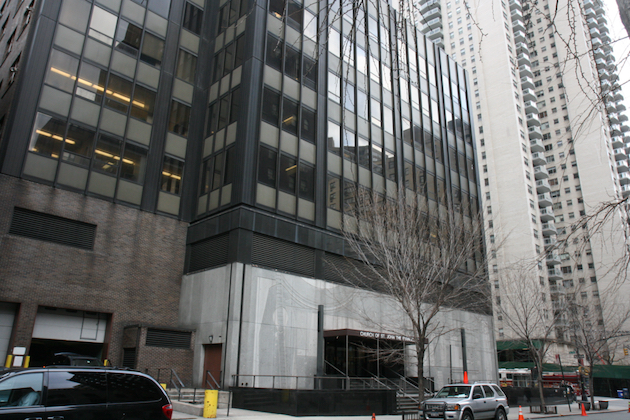
We read much about the “Synodal Path,” the “Synodal Church,” the “Synod on Synodality” and “synodality” itself. Few, however, seem to have noted the remarkable agreement among all the actors involved in these events. The German Synodal Path supposedly was the product of the unique nature of the German Church: bureaucratic, historically antagonistic to “Rome” and enjoying the benefits of the Church Tax. Yet similar recommendations were soon forthcoming in France and Ireland. Then, the allegedly “conservative” Church of the United States issued its own “national synthesis” which has a surprising resemblance to the positions taken by the Germans. For example, the USSCB summary found among the main issues facing the Church:
Closely related to the wound of polarization is the wound of marginalization :
Those who experience marginalization, and thus a lack of representation in the Church, fall into two broad groups.16 The first includes those marginalized who are made vulnerable by their lack of social and/ or economic power, such as immigrant communities; ethnic minorities; those who are undocumented; the unborn and their mothers; people who are experiencing poverty, homelessness, or incarceration; those people who have disabilities or mental health issues; and people suffering from various addictions. Included also in this group are women, whose voices are frequently marginalized in the decision-making processes of the Church: “women on parish staff said they felt underappreciated, underpaid, not supported in seeking formation, worked long hours, and lacked good role models for self-care.”17 The second group includes those who are marginalized because circumstances in their own lives are experienced as impediments to full participation in the life of the Church. Among these are members of the LGBTQ+ community, persons who have been divorced or those who have remarried without a declaration of nullity, as well as individuals who have civilly married but who never married in the Church. Concerns about how to respond to the needs of these diverse groups surfaced in every synthesis.
Persons who have been divorced, whether remarried or not, often feel unwelcome within the Church.
The hope for a welcoming Church expressed itself clearly with the desire to accompany with authenticity LGBTQ+ persons and their families. …In order to become a more welcoming Church there is a deep need for ongoing discernment of the whole Church on how best to accompany our LGBTQ+ brothers and sisters.
There was a desire for stronger leadership, discernment, and decision-making roles for women – both lay and religious – in their parishes and communities.
Synodal consultations identified that more work is necessary to welcome diverse cultural and ethnic communities. 1)
This consensus extends not just across borders but up and down the chain of authority in the Church. The archdiocese of Philadelphia, for example, produced its own statement pf priorities completely in accord with those mentioned above. Artwork arising out of those sessions in Pennsylvania was subsequently republished by the Vatican. In Rome, Cardinal Mario Grech has defended the German Synodal Path against is critics in other hierarchies.
Finally, the continuity extends across time as well as space. In 1976 the famous Call to Action conference was held in Detroit with the support and participation of senior members of the American hierarchy. In substance, its characterization of the issues facing the church resembles closely those of the synodal reports of today. 2) In Germany, the Würzburg synod held between 1971 and 1975 anticipated in many respects the current Synodal Path.
The number and specificity of the demands or proposed actions vary among these declarations, conferences and “processes.” But the underlying issues that are identified are generally the same. How can we account for this extraordinary unanimity? After all, hasn’t the Church throughout the world and over recent decades been characterized by tensions between conservatives and progressives, traditionalists and liberals? Yet, when the Church undertakes a project to “listen” to its base, only one perspective emerges, only one set of priorities is deemed worthy of comment.
One obvious fact is that in all these meetings, conferences and sessions the same people and the same institutions are involved. They are the bureaucrats who in fact run the Catholic Church, regardless of post-Conciliar talk of an empowered laity, subsidiarity or synodal government by the bishops. They include the teachers and administrators at the Catholic educational institutions, the journalists of the Catholic press, the members of the mainstream religious orders, the administrators of dioceses, the staffs of national episcopal conferences and the leadership of catholic organizations of every kind. The Roman curia, along with its related and subordinated entities, is itself one of the foremost examples. Note that the administrators of the Church include (or form close alliances with) many not officially in the Church’s employ. Members of the “engaged” or ”activist” laity, for example, can be counted among the partners of the bureaucracy. Other allies have found a home as teachers or students at secular universities and divinity schools. The publication perhaps most representative of the views of the Roman Catholic bureaucracy – the National Catholic Reporter – was specifically founded in the 1960’s outside the formal perimeter of the Church.
The make-up of the bureaucracy has shifted over the years – there are far fewer priests and nuns today in comparison to 1976 or 1966 – but that has hardly diminished its role. Most of the few religious sisters that remain no longer serve in schools or hospital but as administrators of one kind or another. Jesuits today rarely are able to staff their own schools and universities but direct and decisively influence their lay disciples who manage these places.
The actual number of administrators has undoubtedly steadily increased. Many bishops and diocesan priests also have come to understand their function to be links in a bureaucratic chain. Moreover, the bureaucratic tide is daily conquering new territory. Pope Francis has just decreed that laymen and women can lead Vatican congregations and dicasteries. A woman has just been appointed as akind of “deputy vicar general” in a German diocese. 3)
These bureaucrats and their hangers-on are the ones who select the issues to be addressed in the synodal process and formulate the “solutions” for them. Not even the ”1%” supposedly surveyed in the synodal process has had any real say in the matter.
This institutional stability is linked with ideological uniformity. The ascendancy of the ecclesiastical bureaucracy, although its roots reach much further back, is really the product of Vatican II. For it was in the wake of the Council that the functionaries were empowered to assume the direction of the Church. They internalized and perpetuated the basic twofold nature of the Council: a revolutionary reaction against all forms of the past in Catholicism, combined with total openness to the norms of contemporary society. It’s easy to see how seductive such a message is for modern administrators. As against the laity and “reactionary” elements of the clergy they could pose as bold innovators in an ongoing, endless process of change. In relation to the powers of secular society – both in and outside of the state – they could appear as accommodating fellow citizens of modernity. Therefore, at all times the Church bureaucracy has remained the guardian of the progressive vision.
These continuities in structure and belief within the Catholic Church reflect the consolidation of the modern civil society of the West and of its ideology. As in the case of the Church, the cultural and structural unity of the secular world extends over all Western societies (cf. Thomas Molnar’s Atlantic Culture). Moreover, just like the Church bureaucracy, the secular power elite includes both state (governmental) and private institutions and players. The Church operates within this society, and after the Council explicitly has looked to it for guidance. In secular society too, there has been continuity in ideology since the 1960’s, even if developments steadily assume a more and more extreme form. The “woke” ideology dominant today would have exceeded the expectations of all but a fringe of extreme radicals fifty years ago. But on such issues as support of unrestricted abortion the secular establishment has been consistent over the decades.
Now the controlling influence of secular society is evident not only in the political and moral positions adopted by the Church administrative functions, but also in the very fact of the bureaucratic ascendancy within the Church. For is not the introduction of the managerial revolution one of the hallmarks of the contemporary world? Political conservatives have long lamented the deep state, impervious to political control and following its own agenda. A whole literature has arisen on these developments in the American educational system, where at every level the rate of growth of administrative staffs far exceeds that of both students and teachers.
Continuities of institutions, people, and ideology – all embedded in a supportive secular society – explain why the progressive Catholic vision has been so resistant to change – and now directs the synodal process. Catholic conservatives and traditionalists have been slow to understand or acknowledge these facts. Years ago, James Hitchcock wondered why conservative priests turn “middle of the road” or even progressive on becoming bishops. Others were amazed at how little headway the ideas of Popes John Paul II and Benedict seemed to make in the Church. The fact of Catholic bureaucratic continuity helps to clarify the situation. For those who dispute the consensus expressed in the synodal documents it will be insufficient to write grand speeches and articles and otherwise engage in intellectual debate. They must accept the necessity of relentless conflict with a concretely existing establishment holding all the power. It’s a struggle that, in the short term, has no immediately foreseeable resolution.
In the long term, as we know, the outcome will be quite different.
Contact us
Register
- Registration is easy: send an e-mail to contact@sthughofcluny.org.
In addition to your e-mail address, you
may include your mailing addresss
and telephone number. We will add you
to the Society's contact list.
Search
Categories
- 2011 Conference on Summorum Pontifcum (5)
- Book Reviews (95)
- Catholic Traditionalism in the United States (24)
- Chartres pIlgrimage (17)
- Essays (176)
- Events (670)
- Film Review (7)
- Making all Things New (44)
- Martin Mosebach (34)
- Masses (1,343)
- Mr. Screwtape (46)
- Obituaries (15)
- On the Trail of the Holy Roman Empire (22)
- Photos (347)
- Pilgrimage Summorum Pontificum 2021 (7)
- Pilgrimage Summorum Pontificum 2022 (6)
- Pilgrimage Summorum Pontificum 2023 (4)
- Sermons (79)
- St. Mary's Holy Week 2019 (10)
- St. Mary's Holy Week 2022 (7)
- St. Mary's Holy Week 2023 (7)
- St. Mary's Holy Week 2024 (6)
- Summorum Pontificum Pilgrimage 2024 (2)
- Summorum Pontificum Pilgrimage 2025 (7)
- The Churches of New York (198)
- Traditionis Custodes (49)
- Uncategorized (1,376)
- Website Highlights (15)
Churches of New York
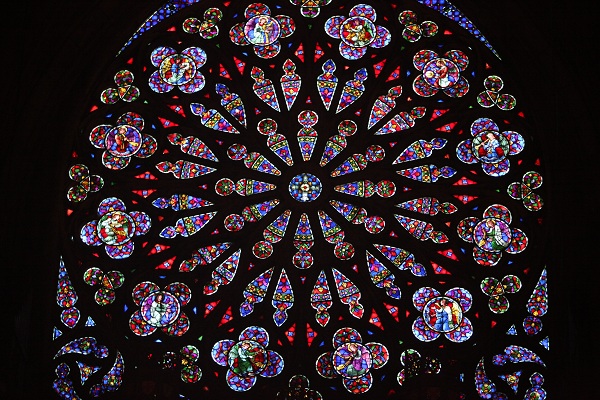
Holy Roman Empire

Website Highlights
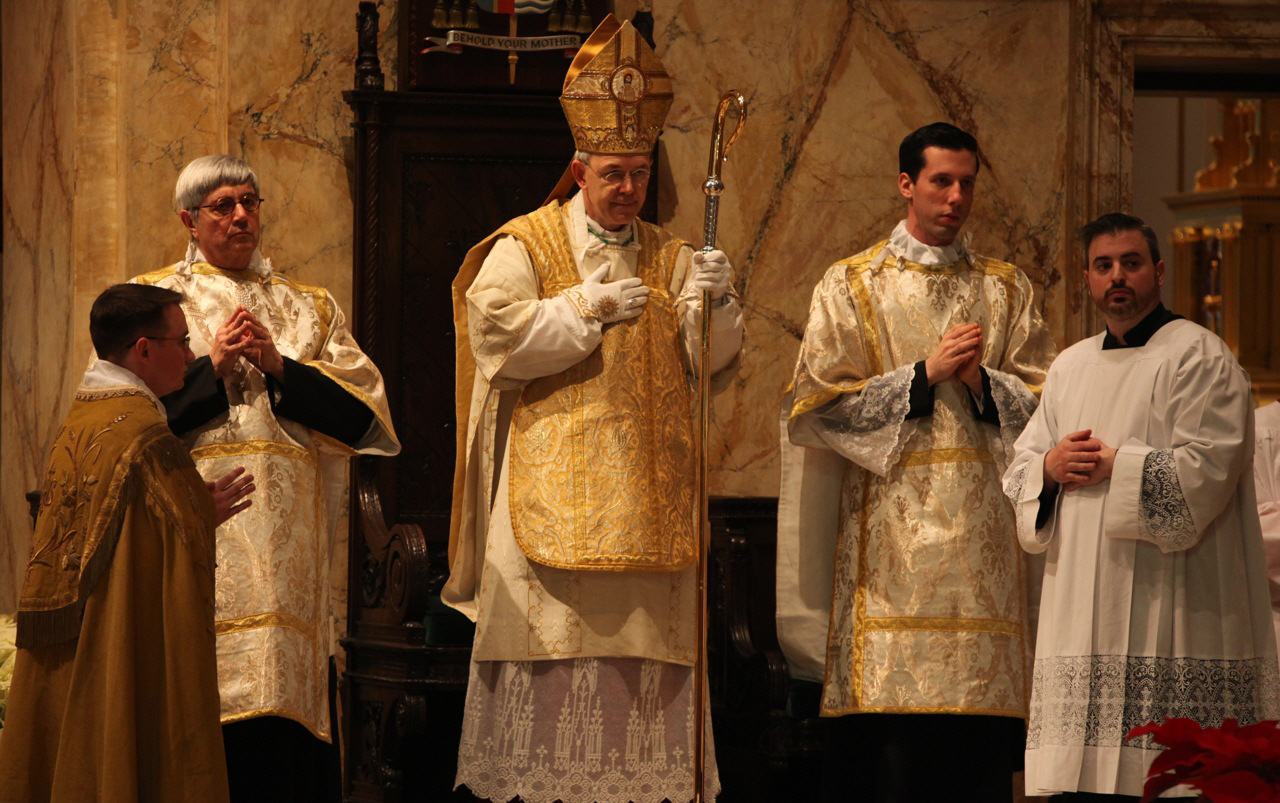
Archives

[powr-hit-counter label="2775648"]
